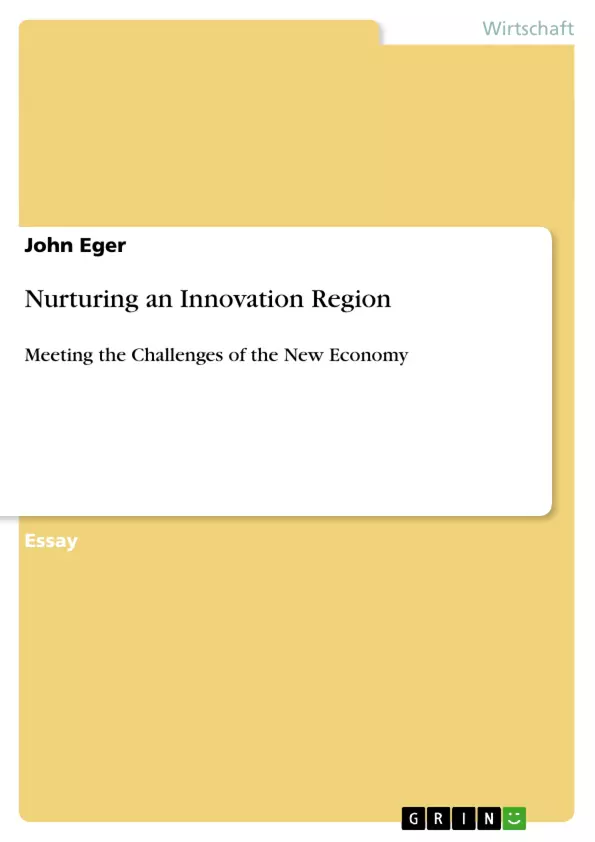The world has undergone dramatic changes due to the pervasive spread of the Internet, the marriage of computers and telecommunication, and the shift to a global economy. Cities, regions, and nations everywhere face an uncertain challenge in the wake of globalization.What we do in the next few years to reinvent our civilization, our political, social and economic institutions, and, importantly, our schools to meet the challenges of this new economy will determine whether our cities and communities survive and succeed or atrophy and die…in this new world order. This essay examines the challenges to regions and local communities, to education, and to parents, politicians and policymakers in the U.S. and indeed, across the world.
Inhaltsverzeichnis
- Preface
- II. Introduction
- III. The Creativity Community
- A. The Global Economy
- B. The City of the Future
- C. The Creative City
- 1. The Creative Community: A New Paradigm
- 2. The Creative City: A Vision for the Future
- D. The Creative Economy: A New World Order
- IV. The Role of Art and Culture in Economic Development
- A. Art as a Catalyst for Economic Growth
- B. Culture as a Competitive Advantage
- C. The Creative Economy: A New Way of Thinking About Economic Development
- V. Conclusion
Zielsetzung und Themenschwerpunkte
Diese Arbeit untersucht die Herausforderungen, vor denen Regionen und lokale Gemeinschaften, Bildungseinrichtungen sowie Eltern, Politiker und Entscheidungsträger in den USA und weltweit stehen. Sie betont die Notwendigkeit, sich auf die neue, wissensbasierte Wirtschaft und Gesellschaft einzustellen und die Rolle von Kunst und Kultur bei der Förderung der wirtschaftlichen Entwicklung zu beleuchten.
- Die Bedeutung der Kreativität für den wirtschaftlichen Erfolg in der globalisierten Welt
- Die Herausforderungen der Anpassung an die neue wissensbasierte Wirtschaft
- Die Rolle von Kunst und Kultur bei der Förderung der wirtschaftlichen Entwicklung
- Die Notwendigkeit einer neuen Denkweise über wirtschaftliche Entwicklung
- Die Bedeutung von Bildung und Investitionen in die menschliche Entwicklung
Zusammenfassung der Kapitel
Das Vorwort beleuchtet die weitreichenden Veränderungen, die die Welt durch die Verbreitung des Internets, die Verbindung von Computern und Telekommunikation sowie den Übergang zu einer globalen Wirtschaft erlebt hat. Es unterstreicht die Notwendigkeit, unsere Zivilisation, unsere politischen, sozialen und wirtschaftlichen Institutionen und insbesondere unsere Schulen neu zu erfinden, um den Herausforderungen dieser neuen Wirtschaft zu begegnen.
Die Einleitung untersucht den Kampf amerikanischer Städte, sich für die neue postindustrielle Wirtschaft und Gesellschaft neu zu erfinden, die der Harvard-Soziologe Daniel Bell in den 1960er Jahren vorausgesagt hat. Sie betont die Bedeutung der Informationsinfrastruktur in der heutigen Zeit, in der Informationen zum wertvollsten Gut geworden sind.
Das Kapitel "The Creativity Community" beschäftigt sich mit der Bedeutung einer kreativen Gemeinschaft, die die enge Verbindung zwischen Kunst, Kultur und Wirtschaft nutzt und die notwendigen Ressourcen investiert, um ihre Bürger auf die Herausforderungen der sich schnell entwickelnden postindustriellen, wissensbasierten Wirtschaft und Gesellschaft vorzubereiten.
Schlüsselwörter
Kreativität, Wirtschaftliche Entwicklung, Kunst, Kultur, Innovation, Globale Wirtschaft, Wissensbasierte Gesellschaft, Bildung, Stadt der Zukunft.
- Quote paper
- Professor John Eger (Author), 2012, Nurturing an Innovation Region, Munich, GRIN Verlag, https://www.grin.com/document/189585



